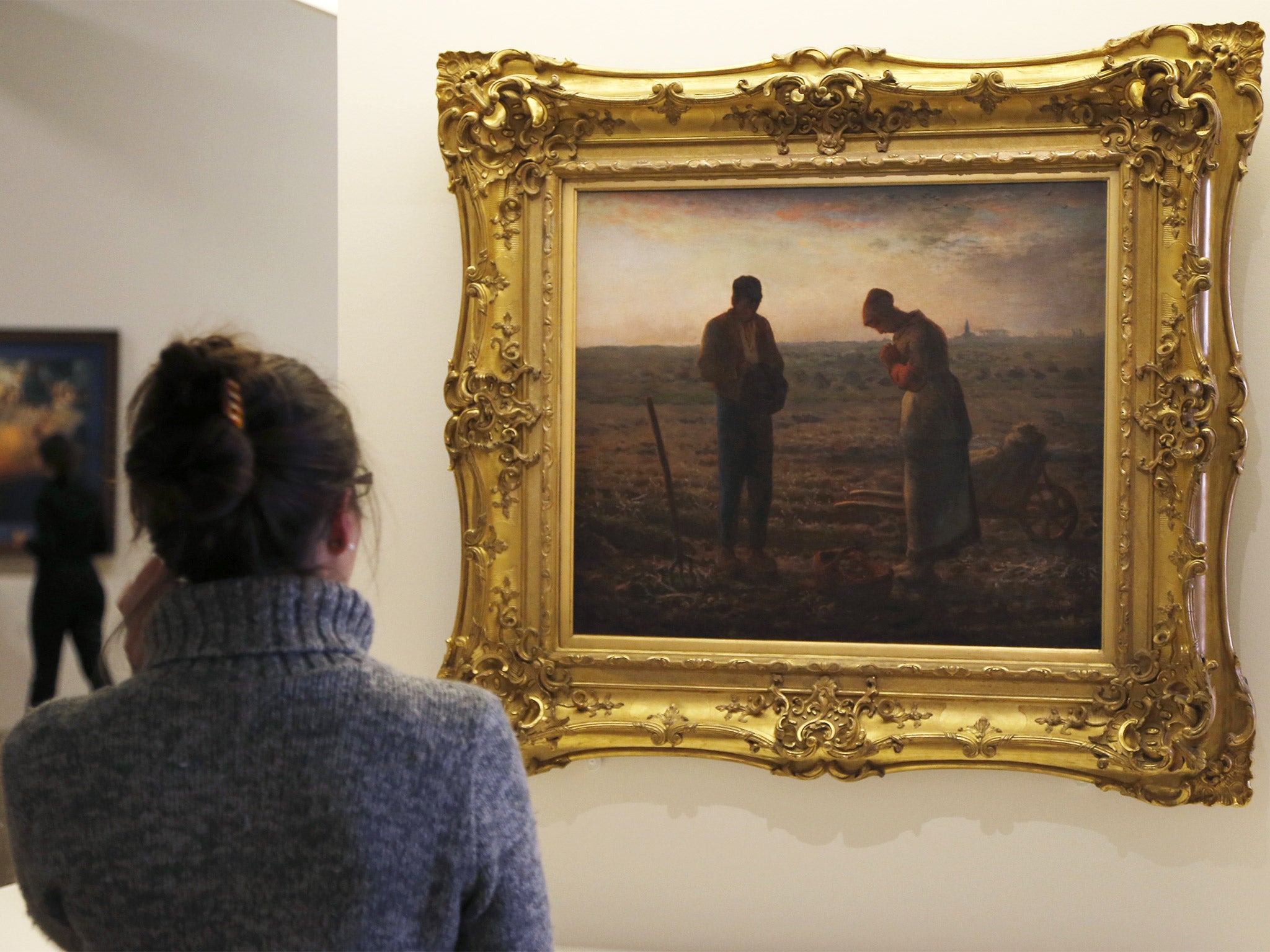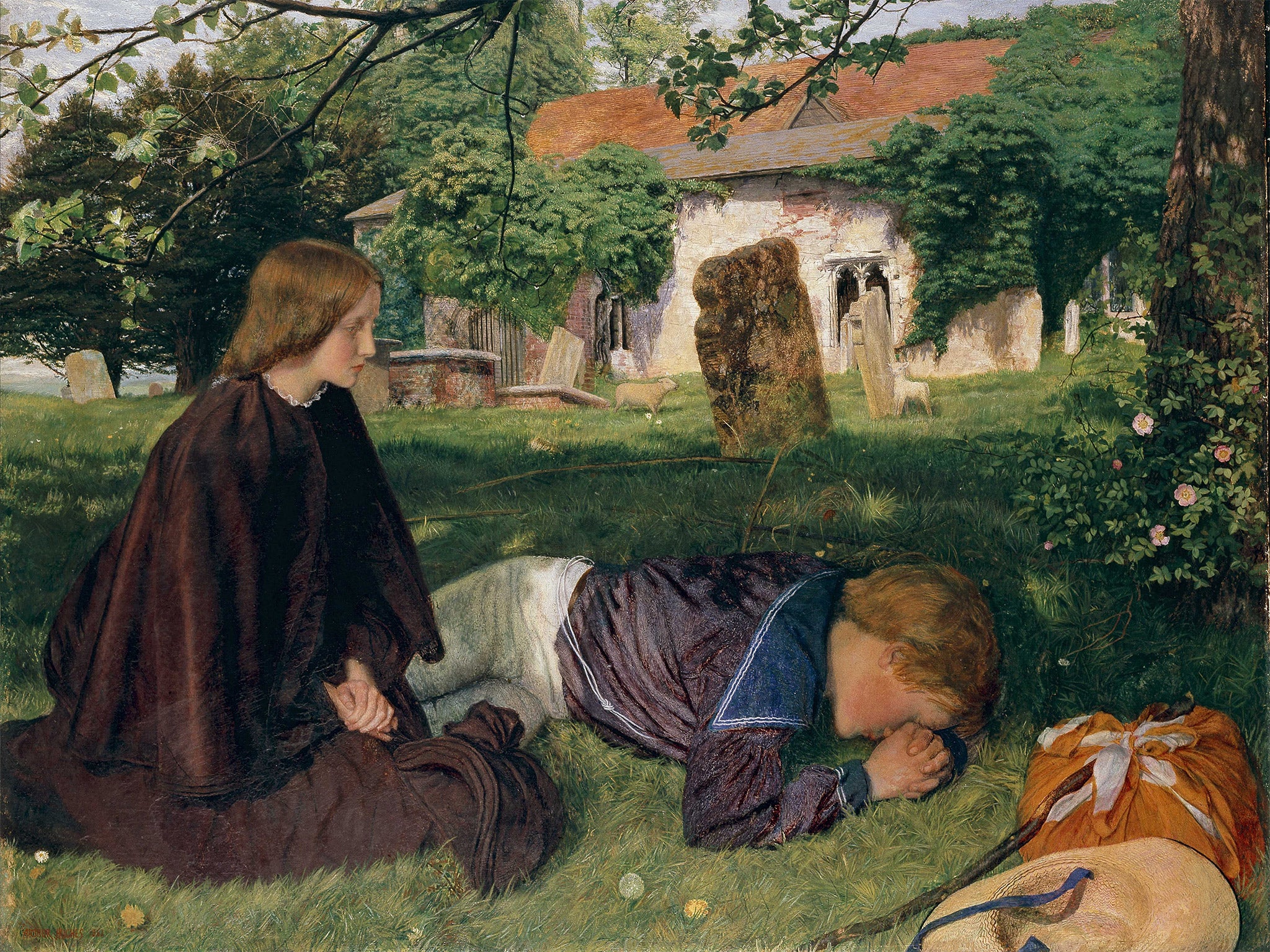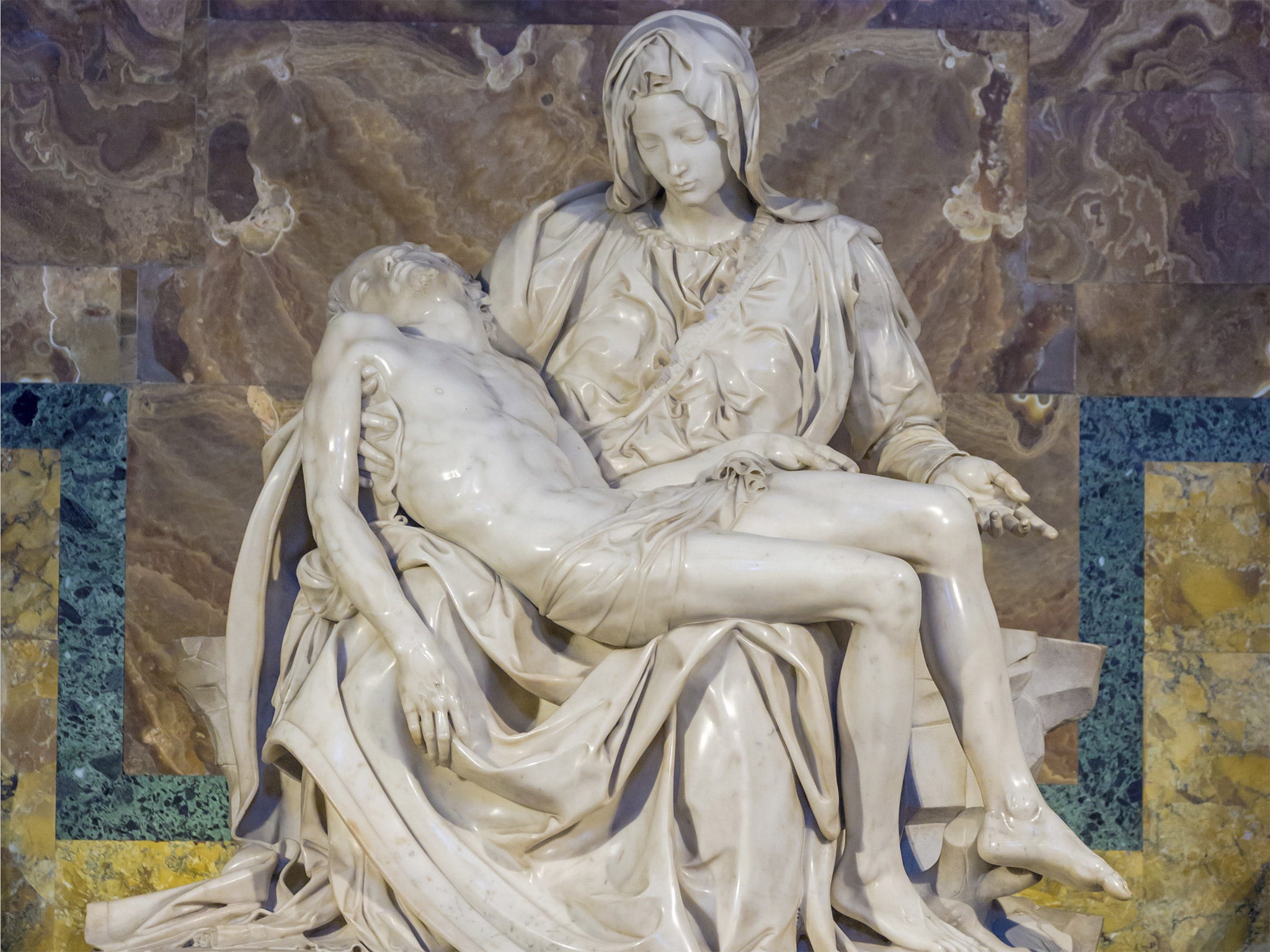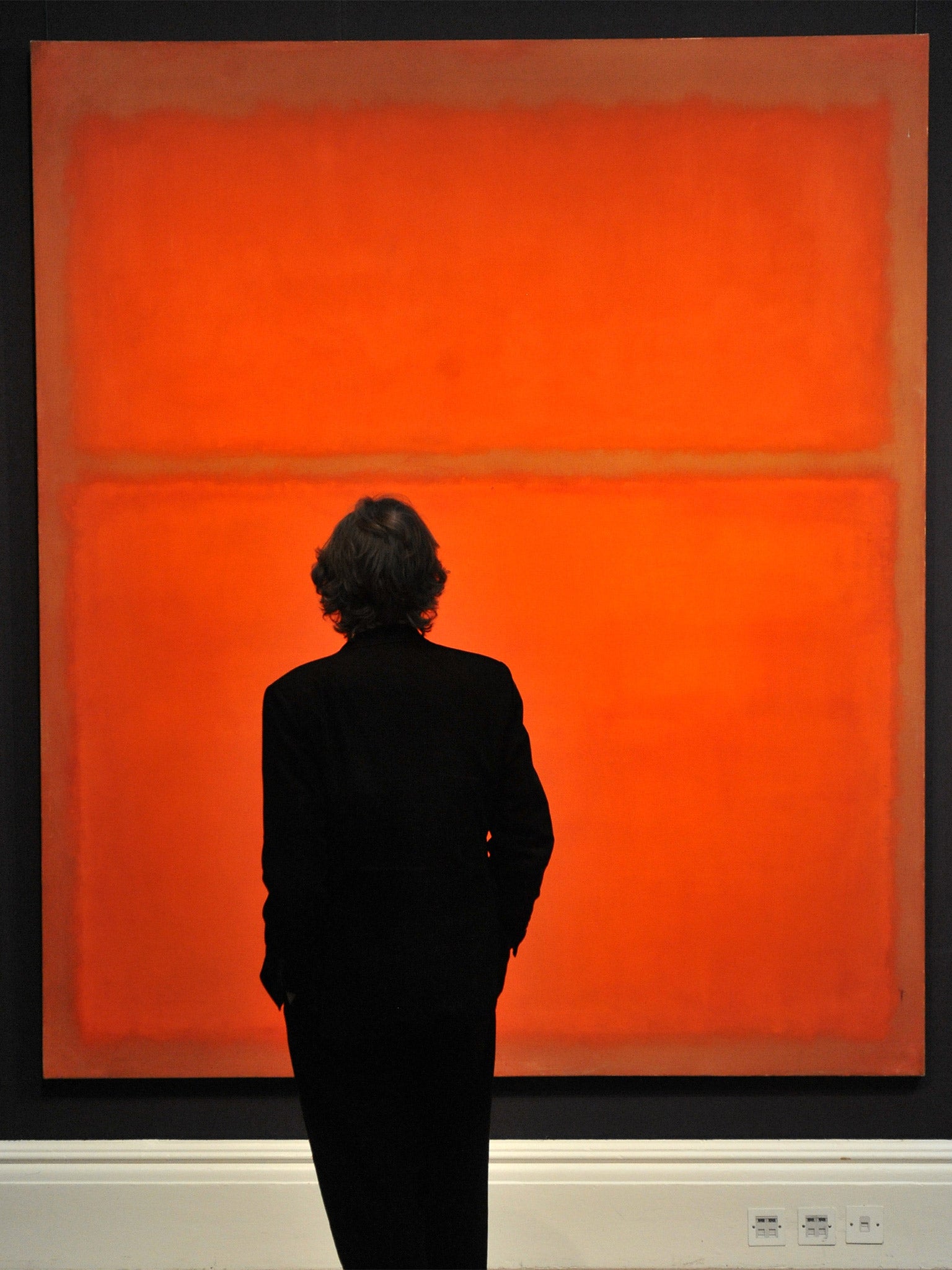From Millet's The Angelus to Rothko, why do some works of art make us cry?
In the 19th century, Millet's 'The Angelus' moved people to tears. These days, Rothko is thought to be the most wept-over artist. Philip Hook explores the etiquette of getting emotional in galleries

Your support helps us to tell the story
From reproductive rights to climate change to Big Tech, The Independent is on the ground when the story is developing. Whether it's investigating the financials of Elon Musk's pro-Trump PAC or producing our latest documentary, 'The A Word', which shines a light on the American women fighting for reproductive rights, we know how important it is to parse out the facts from the messaging.
At such a critical moment in US history, we need reporters on the ground. Your donation allows us to keep sending journalists to speak to both sides of the story.
The Independent is trusted by Americans across the entire political spectrum. And unlike many other quality news outlets, we choose not to lock Americans out of our reporting and analysis with paywalls. We believe quality journalism should be available to everyone, paid for by those who can afford it.
Your support makes all the difference.People weep at concerts when listening to transcendent music; people weep watching films or reading sad books; but fewer tears are shed in front of works of visual art. In the hierarchy of arts that provoke strong emotional reaction, painting and sculpture are some way down the list. There is something about the static nature of a work of plastic art that puts it at an emotional disadvantage by comparison with the greater dynamism and temporal flexibility offered by music, film or books. But are we beginning to change? Is it my imagination, or are more people weeping at art today?
In the past, if you came across someone shedding tears in an art gallery you would be more likely to assume that they'd had a bit of bad news than that the art had brought it on. Certainly that was the reaction of the Impressionist painter Pissarro when visiting an exhibition of the works of Jean-François Millet in Paris in 1887. He bumped into an acquaintance who "greeted me with the announcement that he had just received a great shock, he was all in tears. I thought someone in his family had just died. Not at all, it was The Angelus, Millet's painting, which had provoked this emotion. This canvas, one of the painter's poorest, a canvas for which in these times 500,000 francs was refused, has just this moral effect on the vulgarians who crowd round it."
Pissarro was a little peeved at this point in his career because his own paintings weren't selling as well as Millet's. But he identifies two valid concerns here: the unthinking mass appeal of a familiar image; and the genuineness of the emotion that viewing it produces. Was a lot of money offered for The Angelus because it made people so emotional? Or was the emotion triggered by the amount of money offered for it?
Spectators of works by Mark Rothko, the American Abstract Expressionist, are often moved to tears. There is something about the large expanses of colour which the artist deploys with such subtlety that puts the viewer in touch with the absolute. Awed by these visions of infinity, many break down and cry. The Rothko Chapel in Texas is a popular destination for art lovers, its interior exclusively decorated with large abstract Rothkos. One should not be surprised to discover that, besides security guards, there are also counsellors on duty to offer comfort to those visitors overcome with emotion. These weepers are at the opposite pole from the spectators in the salesroom who break out into spontaneous applause when a Rothko sells for $78m. Or are they? Perhaps it is gratifying to find your emotion priced so high.
Art lovers of the 18th century were not afraid to shed tears. Indeed they rather gloried in them: Diderot, the French philosopher, exhorted painters to "move me, astonish me, unnerve me, make me tremble, weep, shudder, rage, then delight my eyes afterwards if you care to". And 50 years later, the notoriously susceptible writer Stendhal likens himself to the sounding board of a violin, echoing and responding to the emotional vibrations of the work of art he is encountering. One day in Florence he is overwhelmed by a viewing of the Sibyls of Volterrano in the church of Santa Croce. "I got into a state of emotion where the celestial sensations of the fine arts encounter impassioned sentiments," he records. "When I left Santa Croce I had palpitations of the heart, felt beside myself and feared to fall down." Experiencing psychosomatic dizziness and hallucinations when viewing art is now given a medical name – Stendhal Syndrome.

But back to Rothko. He wrote of his work: "I'm interested only in expressing basic human emotions, and the fact that lots of people break down and cry when confronted with my pictures shows that I communicate those basic human emotions. The people who weep before my pictures are having the same religious experience I had when I painted them."
Rothko's use of the word "religious" here is significant. It hints at the changing role of art in society, and people's emotional response to it. In the past a spectator might contemplate a great work of Christian art – perhaps Michelangelo's Pieta – and be moved to tears because of its religious content. Now art doesn't have to be religious in the traditional sense to elicit intense emotion. Spectators can be moved to tears by art simply because it is art. That is because art – even in its most secular form – has become the religion of the 21st century. Art meets a spiritual need in people that was previously met elsewhere. It has filled a vacuum in our society left by religion. The great art galleries of the land are its new cathedrals.
A large number of the people who a generation or two ago might have taken their children to church on Sundays now take them to an art gallery instead. You see them, the well-intentioned classes, anguished by the same reluctance of their little Emilys and Caspars to appreciate the works of Gerhard Richter when chivvied into Tate Modern, as they might formerly have been by their failure to remember the words of the Nicene Creed when funnelled into pews. In Britain today, there is the same reverence accorded to the director of the Tate or the director of the National Gallery as used to be accorded to the Archbishops of Canterbury and York. There are saints, too, in the canon of the church of art, martyrs like Van Gogh whose self-sacrifice and commitment to their artistic ideals in the face of discouragement are as thrilling and inspiring to the faithful as the old Christian ones.

Van Gogh's life and art have the capacity deeply to touch people. His is the classic artistic back-story, involving commitment to his art, loneliness, professional rejection, bouts of madness, and early death by suicide. So the spectator interprets his paintings through the prism of what he already knows about the romantic tragedy of the artist's life. And it's not difficult to read into the frenzied brush strokes evidence of acute suffering. It's a powerful combination, and little wonder that Van Gogh's works are among the most tear-jerking to art-loving audiences.
I once went to visit a very, very rich collector who was justifiably proud of his Van Gogh, a particularly tortured landscape. "Wait," he told me, "before you look at it I just have to switch something on." I imagined that it was some aspect of the lighting that he wanted to adjust. He re-emerged satisfied and ushered me forward. When I was exactly a metre and a half from the painting the sound system was activated. The room was abruptly flooded with the voice of Frank Sinatra bursting into "My Way". "I'm sorry," the owner said at the end of the song, dabbing his eyes with a handkerchief. "That painting always makes me cry." But perhaps this was cheating: I'm not sure he would have wept without the Sinatra contribution.
Then again things aren't always what they seem. Once, in the Hermitage Museum in St Petersburg, I watched a very beautiful young woman looking very intently at a Rembrandt self-portrait. She was deeply involved in what she saw, and I was moved by how much she appeared to be moved. I fancied I saw a tear in her eye, even though she seemed to be trying to hide it by discreet motions of her hand. I went closer. Then it dawned on me: the painting was glazed, and she was using the glass as a mirror to adjust her mascara.
I have to confess that I have never actually shed tears in front of a painting myself. But then, I am English. Paintings that move me strongly tend to be those which impress me as literature does, which arouse my sympathies like a novel. I have to have a handkerchief ready – just in case – whenever I go into the Ashmolean Museum in Oxford. A painting by the Pre-Raphaelite artist Arthur Hughes hangs there, called Home From Sea. It shows a young sailor boy lying in the grass weeping at the grave of his mother. She has died while he has been away on his first voyage, and his older sister kneels mournfully beside him. The setting is an idyllic English churchyard, with sun dappling the ancient church walls beyond. The face of the boy in profile as he buries his face in his hands, and the detail of the strands of hair matted by tears to the side of his cheek are almost unspeakably sad.

We live in an age in which people are much more prone to crying publicly. It is accepted on reality television shows, even encouraged by ratings-seeking programme planners. Footballers do it after missing crucial penalties. Celebrities do it so much on screen that it's become a fashion statement. As a nation, we have lost our stiff upper lips. And art is no different. The same lack of boundaries which are a feature of contemporary art, in which just about anything goes, also applies to our emotional responses to it. We have loosened up.
But still, there remain some standards as far as art is concerned. An etiquette prevails, even with Stendhal Syndrome. Which artists' work is it OK to be seen crying in front of, and which not? Rothko is consecrated by custom, as attested by his many admirers. And truly sublime works by the great masters may justifiably provoke tears. But even here, some discrimination must be exercised: yes, cry in front of a self-portrait by Rembrandt in his old age, or Picasso's Guernica. But people might still look at you oddly if they saw you shedding tears in front of Frans Hals's Laughing Cavalier or a piece of rococo frippery by Fragonard.
Then there are the artists whose works it is probably difficult ever to justify weeping in front of. Take the Pop artist Richard Prince, for instance: surely the proper response to his painted texts in which he recycles popular "jokes" is laughter rather than tears. And what about Jeff Koons? His vast shiny Balloon Dog sculpture might elicit many emotions, but tears would not be among them. Unless you were reflecting on the opportunity you passed up 10 years ago to buy one for $5m when they now sell for $50m.
Philip Hook is the author of 'Breakfast at Sotheby's: An A-Z of the Art World' (Penguin, £7.99), which is out now
Join our commenting forum
Join thought-provoking conversations, follow other Independent readers and see their replies
Comments